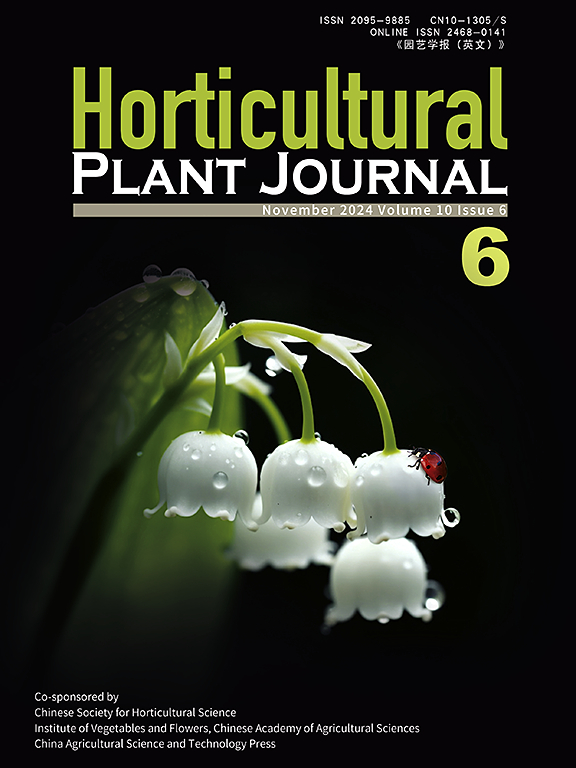杏仁从苗圃到食物链溯源的基因组学方法
IF 5.7
1区 农林科学
Q1 HORTICULTURE
引用次数: 0
摘要
杏仁因其优质和健康的特点而在世界各地广泛种植。杏仁可新鲜食用或用于食品工业。在漫长的栽培历史中,人们选择了数以百计的杏仁栽培品种;在这种情况下,一种有效的品种鉴定方法对于确保栽培品种在整个产业链中的可追溯性至关重要。本研究调查了从多种杏仁基质(包括杏仁叶、杏仁核(新鲜和烘焙)以及多种加工产品)中提取 DNA 的广泛使用的商业试剂盒和方案。在从所有测试基质中分离出适合分子分析的 DNA 方面,商业试剂盒(尽管略有改动)优于其他提取方法。与此同时,利用 Axiom™ 60K 杏仁 SNP 阵列对由 140 个登录品种(123 个西西里基因型,以及广为人知的国内和国际栽培品种)组成的种质集合进行了基因分型,从而检测出 6 374 个独特的 SNPs,这些 SNPs 可随时用于品种溯源。利用高分辨率熔解(HRM)测定法对包含十个最广泛栽培品种的发现面板上的独特 SNP 子集进行了进一步验证。从 5 个栽培品种的叶片和果核中提取的 DNA 通过 8 个 SSR 进行了基因分型,从而确定了每个果核的母本来源。论文将对广泛使用的 DNA 提取方案的调查与 140 个杏仁品种的高通量基因分型相结合。在此背景下,经过验证和优化的独特 SNPs 用于 HRM 检测,SSR 标记的可用性证明了它们在产业链溯源分析中的功效。本文章由计算机程序翻译,如有差异,请以英文原文为准。
Genomic approaches for almond traceability from nursery and along the food chain
Almond is widely cultivated in the world thanks to the quality and healthy features of the kernel. Almond kernel is consumed fresh or employed in the food industry. Hundreds of almond cultivars were selected throughout the long history of cultivation; in this context, an efficient method for varietal identification is essential to ensure cultivar traceability along the chain. This study surveyed the widely employed commercial kits and protocols for DNA extraction from several almond matrices including leaves, kernels (fresh and roasted) and several processed products. Commercial kits (though with minor modification) outperformed the other extraction methods for the isolation of DNA suitable for molecular analysis from all the tested matrices. In parallel, a germplasm collection composed of 140 accessions (123 Sicilian genotypes complemented with widely known national and international cultivars) was genotyped with the Axiom™ 60K almond SNP Array enabling the detection of 6 374 unique SNPs that can be readily used for varietal traceability. A subset of unique SNPs was further validated employing a high-resolution melting (HRM) assay on a discovery panel encompassing ten of the most widely cultivated accessions. The DNA extracted from leaves and kernels of five cultivars was genotyped with eight SSRs allowing the identification of the maternal origin of each kernel. The paper integrates the survey of the widely employed protocols for DNA extraction with the high-throughput genotyping of 140 almond accessions. In this context, unique SNPs validated and optimized for an HRM assay and the availability of SSR markers demonstrated their efficacy in traceability analysis along the chain.
求助全文
通过发布文献求助,成功后即可免费获取论文全文。
去求助
来源期刊

Horticultural Plant Journal
Environmental Science-Ecology
CiteScore
9.60
自引率
14.00%
发文量
293
审稿时长
33 weeks
期刊介绍:
Horticultural Plant Journal (HPJ) is an OPEN ACCESS international journal. HPJ publishes research related to all horticultural plants, including fruits, vegetables, ornamental plants, tea plants, and medicinal plants, etc. The journal covers all aspects of horticultural crop sciences, including germplasm resources, genetics and breeding, tillage and cultivation, physiology and biochemistry, ecology, genomics, biotechnology, plant protection, postharvest processing, etc. Article types include Original research papers, Reviews, and Short communications.
 求助内容:
求助内容: 应助结果提醒方式:
应助结果提醒方式:


